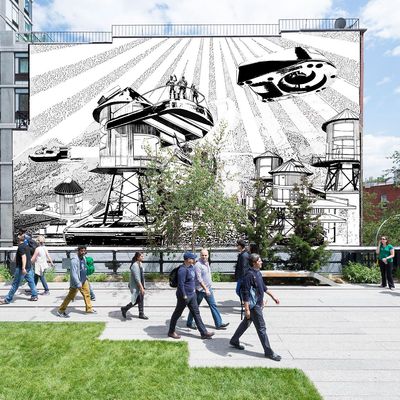
Can the High Line get away with critiquing the High Line (or at least the gentrification it put into hyperdrive) on the High Line itself? In the six years since the first phase of the abandoned industrial railroad reopened as a tourist promenade, empty lots have become multi-million-dollar condos seemingly overnight. The park has also spawned more and more of its own kind, sprouting minimalist urban platforms like those outside the new Whitney. The High LineÔÇÖs curator and director of art, Cecilia Alemani, can barely keep up.
ÔÇ£We used to have a┬ábig billboard that we used for four years ÔÇö we canÔÇÖt use it anymore,ÔÇØ said Alemani, who has made a habit of installing works by the likes of Ed Ruscha, Rashid Johnson, and El Anatsui within and in view of the park, over the phone (sheÔÇÖs in Venice, naturally). ÔÇ£The city changes so radically around the High Line that with the art program, we need to adjust. ThereÔÇÖs a new rooftop, but the wall that you always loved has been demolished.ÔÇØ
The cityÔÇÖs churn makes AlemaniÔÇÖs upcoming project ÔÇö a mural by artist Kerry James Marshall that will replace a previous piece by Ruscha on a wall near West 22nd Street next month, which she is premiering on SEEN ÔÇö feel particularly apropos. The piece, which will be hand-painted by the Brooklyn mural company Colossal Media (they make those faux-artisanal Vans and Jim Beam ads all over the place), depicts a semi-dystopian urban future in which even water towers have been transformed into glassed-in condos overlooking the city. In other words, everything looks like the very Chelsea residential towers that are rising up so quickly behind the High Line.
Titled Above the Line, the piece is MarshallÔÇÖs first public commission in New York City, and it stems from the artistÔÇÖs series of cartoons called ÔÇ£Dailies.ÔÇØ ÔÇ£They feature black superheroes, who are overlooked in contemporary mainstream culture,ÔÇØ Alemani says.
As the glut of unavoidable Marvel superhero blockbusters show, the demographic is largely white. Marshall draws from African-American culture to create new heroes in his ÔÇ£Rhythm MastrÔÇØ series, and looks to African sculpture to inspire superheroic powers.
MarshallÔÇÖs mural encourages different readings, depending on who sees it. The piece makes a previously hidden demographic publicly visible in a visual language ÔÇö comic drawing ÔÇö thatÔÇÖs universally recognizable. But it also functions as ÔÇ£a criticism of whatÔÇÖs happening in the cities, something that local community will appreciate much more,ÔÇØ according to Alemani. ItÔÇÖs a satire of gentrification in its native habitat.
Apart from the flying cars zipping around the glassy condos, the work is recognizable even as it is dystopian. The gentrification visible around Above the Line presages a future in which every part of the city looks like the High Line, stocked with glassy fa├ºades and inaccessible views. ItÔÇÖs an eerily imminent fate, or maybe one already past, in which the city is more striated than ever. Can we escape it?
ÔÇ£This is very much a vision of a futuristic imaginary city, maybe New York City, I donÔÇÖt know!ÔÇØ Alemani says of MarshallÔÇÖs work. ÔÇ£We hope that is not whatÔÇÖs going to happen next to the High Line, but itÔÇÖs almost there.ÔÇØ If we are indeed almost there, almost reaching MarshallÔÇÖs vision of a High LineÔÇôized cityscape, it would only make sense for a former freight railway, not so long ago a rusty, romantic artifact abandoned to the elements, to eventually become a runway for flying cars.

